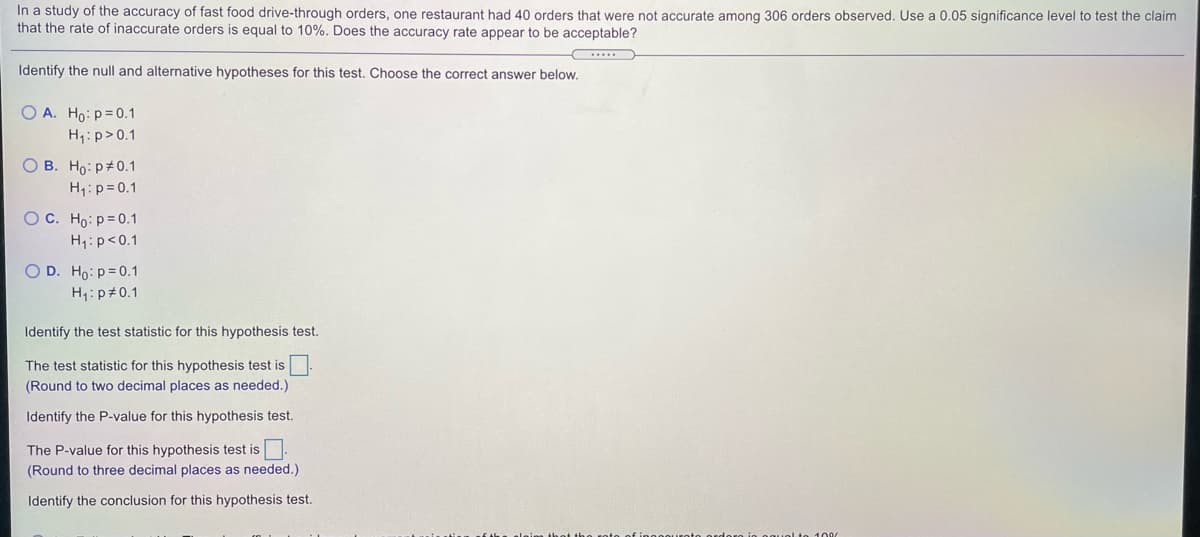In a study of the accuracy of fast food drive-through orders, one restaurant had 40 orders that were not accurate among 306 orders observed. Use a 0.05 significance level to test the claim that the rate of inaccurate orders is equal to 10%. Does the accuracy rate appear to be acceptable? Identify the null and alternative hypotheses for this test. Choose the correct answer below. O A. Ho: p=0.1 H1:p>0.1 O B. Ho: p#0.1 H1: p= 0.1 OC. Ho: p= 0.1 H1:p<0.1 O D. Ho: p= 0.1 H1:p#0.1 Identify the test statistic for this hypothesis test. The test statistic for this hypothesis test is (Round to two decimal places as needed.) Identify the P-value for this hypothesis test. The P-value for this hypothesis test is (Round to three decimal places as needed.) Identify the conclusion for this hypothesis test.
In a study of the accuracy of fast food drive-through orders, one restaurant had 40 orders that were not accurate among 306 orders observed. Use a 0.05 significance level to test the claim that the rate of inaccurate orders is equal to 10%. Does the accuracy rate appear to be acceptable? Identify the null and alternative hypotheses for this test. Choose the correct answer below. O A. Ho: p=0.1 H1:p>0.1 O B. Ho: p#0.1 H1: p= 0.1 OC. Ho: p= 0.1 H1:p<0.1 O D. Ho: p= 0.1 H1:p#0.1 Identify the test statistic for this hypothesis test. The test statistic for this hypothesis test is (Round to two decimal places as needed.) Identify the P-value for this hypothesis test. The P-value for this hypothesis test is (Round to three decimal places as needed.) Identify the conclusion for this hypothesis test.
Glencoe Algebra 1, Student Edition, 9780079039897, 0079039898, 2018
18th Edition
ISBN:9780079039897
Author:Carter
Publisher:Carter
Chapter4: Equations Of Linear Functions
Section: Chapter Questions
Problem 8SGR
Related questions
Question

Transcribed Image Text:Identify the conclusion for this hypothesis test.
O A. Fail to reject Ho. There is sufficient evidence to warrant rejection of the claim that the rate of inaccurate orders is equal to 10%.
OB. Reject Ho. There is not sufficient evidence to warrant rejection of the claim that the rate of inaccurate orders is equal to 10%.
OC. Reject Ho. There is sufficient evidence to warrant rejection of the claim that the rate of inaccurate orders is equal to 10%.
O D. Fail to reject Ho. There is not sufficient evidence to warrant rejection of the claim that the rate of inaccurate orders is equal to 10%.
Does the accuracy rate appear to be acceptable?
O A. Since there is sufficient evidence to reject the claim that the rate of inaccurate orders is equal to 10%, the inaccuracy rate is acceptable.
O B. Since there is sufficient evidence to reject the claim that the rate of inaccurate orders is equal to 10%, the inaccuracy rate is unacceptable, so the restaurant should work to lower
that rate.
OC. Since there is not sufficient evidence to reject the claim that the rate of inaccurate orders is equal to 10%, the restaurant should work to increase that rate.
O D. Since there is not sufficient evidence to reject the claim that the rate of inaccurate orders is equal to 10%, it is plausible that the inaccuracy rate is 10%.
This rate would be too high, so the restaurant should work to lower the rate.

Transcribed Image Text:In a study of the accuracy of fast food drive-through orders, one restaurant had 40 orders that were not accurate among 306 orders observed. Use a 0.05 significance level to test the claim
that the rate of inaccurate orders is equal to 10%. Does the accuracy rate appear to be acceptable?
Identify the null and alternative hypotheses for this test. Choose the correct answer below.
O A. Ho: p= 0.1
H1:p>0.1
O B. Ho: p 0.1
H1: p= 0.1
OC. Ho: p= 0.1
H1:p<0.1
O D. Ho: p=0.1
H1: p#0.1
Identify the test statistic for this hypothesis test.
The test statistic for this hypothesis test is
(Round to two decimal places as needed.)
Identify the P-value for this hypothesis test.
The P-value for this hypothesis test is.
(Round to three decimal places as needed.)
Identify the conclusion for this hypothesis test.
Expert Solution
This question has been solved!
Explore an expertly crafted, step-by-step solution for a thorough understanding of key concepts.
This is a popular solution!
Trending now
This is a popular solution!
Step by step
Solved in 3 steps with 3 images

Recommended textbooks for you

Glencoe Algebra 1, Student Edition, 9780079039897…
Algebra
ISBN:
9780079039897
Author:
Carter
Publisher:
McGraw Hill

Glencoe Algebra 1, Student Edition, 9780079039897…
Algebra
ISBN:
9780079039897
Author:
Carter
Publisher:
McGraw Hill